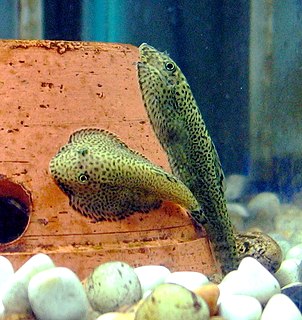This page is based on this
Wikipedia article Text is available under the
CC BY-SA 4.0 license; additional terms may apply.
Images, videos and audio are available under their respective licenses.
Suckerfish or sucker may refer to:

Beaufortia is a genus of woody shrubs and small trees in the family Myrtaceae and is endemic to the south-west of Western Australia. The genus Beaufortia is closely related to Melaleuca, Calothamnus, Regelia and several others, differing mainly in the way the anthers are attached to the stalks of the stamens, and in the way they open to release their pollen. Beaufortia anthers are attached at one end and open by splitting at the other.

Beaufortia kweichowensis is a species of gastromyzontid loach native to rivers in China. The common names for this popular aquarium species are Chinese hillstream loach, Hong Kong pleco, butterfly hillstream loach, and Chinese sucker fish.
Johannes Conrad Schauer was a botanist interested in Spermatophytes. He was born in Frankfurt am Main and attended the gymnasium of Mainz from 1825 to 1837. For the next three years he worked at the Hofgarten of Würzburg. Schauer then gained a position as assistant at the botanical garden at Bonn where he worked until 1832 when he was placed in charge of the botanic garden in Breslau, with C.G. Nees. He gained the degree of Doctor of Philosophy at the University of Erlangen-Nuremberg 1835 and was appointed professor of botany at the University of Greifswald from 1843 until his death in 1848.

Beaufortia sparsa, commonly known as the swamp bottlebrush, is a plant in the myrtle family, Myrtaceae and is endemic to the south-west of Western Australia. It is an erect or spreading shrub with round, dished leaves crowded on the younger stems, and bright red flower spikes in the warmer months.
Beaufortia cyclica is a species of ray-finned fish in the genus Beaufortia.
Beaufortia intermedia is a species of ray-finned fish in the genus Beaufortia.

Beaufortia leveretti is a species of ray-finned fish in the genus Beaufortia.
Beaufortia liui is a species of ray-finned fish in the genus Beaufortia.
Beaufortia pingi is a species of river loach. It occurs in China and Vietnam. It inhabits fast-flowing hill streams and grows to 5 cm (2.0 in) standard length.
Beaufortia polylepis is a species of river loach. It is endemic to the Nanpan River in Yunnan, China. It inhabits rocky streams and measures 3.9–4.8 cm (1.5–1.9 in) standard length.
Beaufortia szechuanensis is a species of ray-finned fish in the genus Beaufortia.
Beaufortia zebroidus is a species of ray-finned fish in the genus Beaufortia.
B. intermedia may refer to:

Beaufortia aestiva, commonly known as Kalbarri beaufortia, is a plant in the myrtle family, Myrtaceae and is endemic to the south-west of Western Australia. It is a dense, usually rounded shrub with small leaves and which bears yellow or red flowers in bottlebrush-like spikes near the ends of the branches in summer. It is similar to Beaufortia squarrosa but that is a smaller shrub which always has red flowers.

Beaufortia schaueri, commonly known as pink bottlebrush, is a plant in the myrtle family, Myrtaceae and is endemic to the south-west of Western Australia. It is a small, rounded shrub with small, crowded, linear leaves and profuse, spherical heads of pink flowers conspicuously displayed on the ends of the branches in spring.

Beaufortia puberula, commonly known as hairy-leaved beaufortia, is a plant in the myrtle family, Myrtaceae and is endemic to the south-west of Western Australia. It is a shrub growing to a height of about 2 m (7 ft) with hairy young leaves and heads of hairy, pink or red flowers during most of the year.
Epomophorinae is a subfamily of megabat.
It was established as a subfamily in 1997.
Epomophorine bats are found only in Africa.






